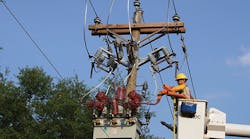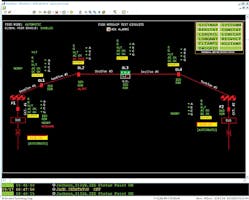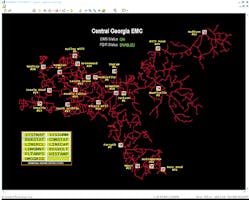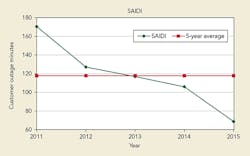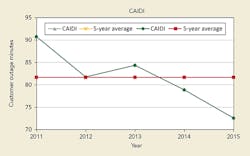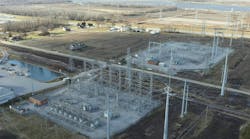In 2013, Central Georgia Electric Membership Corp. (CGEMC) made a strategic decision to improve service reliability. More specifically, the utility made a specific goal to reduce customer outage times, with the improvement to be measured by a reduction in the system average interruption duration index (SAIDI).
An analysis of outage data over a period of several years indicated the CGEMC system experienced 1,200 to 1,400 outages in a typical year. Of this total, about 40 to 50 outages were contributing 60% to 70% of the SAIDI time for a given year. The utility gave due consideration to increasing its efforts to prevent outages, but it quickly became apparent the most effective approach to mitigating large, prolonged outages was to deploy distribution automation (DA) technology.
The DA tool would be expected to isolate power system damage and restore service to as many customers as possible. The required time frame for service restoration was tied to the definition of SAIDI found in IEEE 1366 for distribution systems. With this criterion, any outage with a duration of less than five minutes is not included in the SAIDI total, so the DA tool would be required to complete automated restoration in less than five minutes.
Prior Experience
CGEMC had developed some limited experience with both remote control of sectionalizing apparatus and centralized automation in the years leading up to the decision to implement a DA system. In 2010, CGEMC completed a project to implement power factor correction on each distribution feeder. The project used a combination of fixed and switched capacitor banks to control the volt-ampere-reactive (VAR) flow on individual circuits with a goal of unity power factor.
After two summers of operating the switched capacitor banks in a variety of local control modes (such as VAR, temperature and time of day), CGEMC engineers developed a centralized control algorithm using command sequencing on its Survalent supervisory control and data acquisition (SCADA) system. To implement the centralized control scheme, a reliable communications medium was required to issue the trip and close commands from the SCADA master station to the capacitor control panels. After extensive study and testing, the CGEMC engineering staff selected a cellular technology to act as the communications backbone for the system.
With the experience gained in communicating with capacitor banks, CGEMC engineers then turned their attention to the task of communicating with pole-mounted reclosers. For many years, CGEMC’s SCADA system provided full observation and control of circuit reclosers and voltage regulators in substations, but the utility had not attempted to communicate with down-line apparatus until the centralized capacitor program. By the summer of 2013, CGEMC had approximately 50 pole-mounted reclosers integrated with its SCADA system through cellular communications. Cellular communications gave system operators full control of reclosers, and the engineering staff had access to the control panels to download event records remotely and modify protective relay settings.
The Business Case
The key driver for the DA project was to improve service reliability. The difficulty in justifying a project of this nature is in establishing consensus among the organization’s leadership as to the value of improved reliability. How good must the utility be to be considered good enough? As is often the case, the answer was found through benchmarking.
CGEMC participates in several benchmarking efforts each year, but one in particular caught the attention of corporate decision makers in 2012. A new benchmarking effort, including a closely related peer group, indicated the CGEMC distribution system operated as an outlier in terms of reliability, particularly the SAIDI performance. This new data, which also included the system average interruption frequency index (SAIFI) and the customer average interruption duration index (CAIDI), was helpful in understanding the potential improvement CGEMC could make for the benefit of its customers.
The benchmark five-year averages for CGEMC’s system during this decision process were as follows:
- SAIDI = 130 minutes
- SAIFI = 1.55
- CAIDI = 84 minutes.
The goal of the DA project was to improve reliability to achieve these new targets:
- SAIDI = 84 minutes
- SAIFI = 1.00.
The new targets were established with the expectation a DA tool that isolates power system damage and restores service in less than five minutes should have a significant impact on SAIFI and SAIDI, with less potential for improving CAIDI.
Technology Evaluation and Testing
When the decision was made to pursue a DA project, CGEMC’s first task was to evaluate assets that would act as the foundation for system implementation. The key considerations at this point of the project were distribution network capacity (tie lines), existing sectionalizing equipment and communications capabilities (SCADA).
In the years leading up to the DA project, CGEMC had made a concerted effort to enhance the capacity of the distribution network with the goal of having capacity to shift the load on each substation to alternate sources at 80% of peak load under worse-case weather conditions. The distribution system construction to implement these system improvements was scheduled to conclude in early 2014. As CGEMC engineers surveyed the location of existing sectionalizing equipment that could be used in a DA project, it quickly became clear a relatively large number of devices would be required to complete a systemwide DA deployment. The existing pole-mounted reclosers on the CGEMC system had been placed primarily to enhance the reliability of key commercial and industrial customers. This sectionalizing philosophy was driven by the fact this relatively small group of customers accounts for more than 20% of the utility’s energy sales. While the placement of existing reclosers had improved reliability for key accounts, they had done little to improve reliability for the other 99.85% of CGEMC customers.
The new sectionalizing scheme developed for the DA project had a goal of limiting the impact of a single outage to no more than one-half of a minute of SAIDI. With this goal and the knowledge the historical system average for CAIDI was 84 minutes, a loose guideline of 300 to 350 customers was used as a maximum amount of customers that should be left off after operation of the DA system.
The placement of reclosers along the circuit was designed to sectionalize the feeders into load zones with meter counts that were relatively the same. For example, a feeder with 900 meters would have two normally closed pole-mounted reclosers placed, so there would be three load zones on the feeder, with about 300 meters in each zone. Once the sectionalizing analysis was completed, the utility deemed 111 new reclosers were needed on the system.
With the positive experience gained in communicating with capacitor banks and existing reclosers on the system, cellular communications were an obvious choice to use in expanding the SCADA network to integrate the new reclosers. The combination of reclosers and cellular communications had proven to be a successful program for CGEMC. The reclosers served as a cost-effective alternative to motor-controlled gang switches, especially when dead-line switching was considered.
The use of reclosers avoids the expense and maintenance issues related to the relatively large batteries required to power motor-operated gang switches under dead-line conditions. However, the reclosers do have small batteries integrated to power the control panels. One advantage of cellular communications over other types of wireless communications is the low power required to operate the cellular devices. With such low power requirements, the cellular devices can be powered from the batteries already available in the recloser control panels.
Automation Engine
With distribution network capacity, sectionalizing plans and communications under control, the other key element in planning the DA deployment was to select the software tool to act as the automation engine. CGEMC considered several different approaches to automation prior to making its final decision. The most fundamental point of consideration was the comparison of local peer-to-peer automation versus a centralized automation scheme.
Generally speaking, the peer-to-peer schemes readily available required a high-speed communications medium between devices, such as fiber optics or specialized point-to-point radios. Also, depending on the circumstances, the peer-to-peer communications may only facilitate the automation communications, and another communications medium (that is, cellular, more fiber optics and additional radios) could be required for SCADA monitoring of device status and other telemetry.
As for a centralized automation scheme, several fundamental requirements must be sound for the system to operate properly. First, an accurate network model of the distribution system is required as the foundation for the system. Second, the communications between the SCADA master station and the field apparatus must be very reliable.
In coming to a decision related to the peer-to-peer versus centralized automation scheme, the utility acknowledged the following factors:
- It had little existing fiber-optic cable in service and limited experience with high-speed point-to-point radio systems.
- It had considerable experience with system network modeling. Also, a sub-meter accurate field inventory had been completed a couple of years prior to the DA project considerations.
- It was confident in the cellular communications network throughout its territory.
With these considerations in mind, CGEMC decided its cellular network was a natural fit for a centralized control scheme. This had been demonstrated by the positive experience CGEMC had with its centralized capacitor control program.
With a decision made to pursue a centralized DA tool, the utility evaluated several different software packages. The tool selected was Survalent Technology’s fault location, isolation and service restoration (FLISR) package. CGEMC had been a Survalent client for almost 10 years, but the primary driver for selecting the Survalent FLISR system was the functionality available and the plans for system improvement documented in the company’s technology road map.
Testing Phase
Once the specific FLISR package was selected, the utility transitioned to the testing phase of its DA project. The first part of testing was completed in the CGEMC apparatus shop on a system called the minigrid.
Testing on the minigrid lasted for several months before tests were run on a network model. The first network model testing was done on five feeders in a pilot program. All network model testing was first run on a simulation-based test environment before transitioning to the production SCADA system. As portions of the model were imported or changed, each scenario that could trigger an automated response by the FLISR system was simulated to verify the system response.
One the pilot program was fully tested, installation of the 111 new reclosers began. The recloser installations were organized so substations were automated in the order of highest historical SAIDI to lowest. As the reclosers were installed, the final simulations were performed on the associated feeders, so the FLISR scheme could be operated in automatic mode.
Training Plan
Training of CGEMC personnel started while the system was in the minigrid testing phase. The primary training activity was simulation-based training delivered first to linemen and system operators, but the entire CGEMC organization was exposed to the minigrid if for no other reason than to gain familiarity with the new technology. The simulation-based training was found to be highly effective in demonstrating to linemen how the FLISR system worked.
One of the fundamental points delivered during these sessions was the fact the FLISR system does the same thing a system operator does — but it does it really fast. The simulation-based training was most effective for the system operators. They were able to use the simulations developed for testing the system to observe the automated response for every scenario that could trigger FLISR to respond.
These sessions were coupled with manual restoration exercises to ensure system operators gained a thorough understanding of the automation features, and it allowed them to develop familiarity with the new operator views on the Survalent distribution management system (DMS), which facilitated the graphic user interface for the system.
SAIDI Minutes Saved
The FLISR system was fully implemented and running in full automatic mode on Nov. 1, 2014. As of April 30, 2016, 40 automation events have saved an estimated 35 minutes of SAIDI, which is equivalent to about 1.85 million customer minutes of outage time avoided.
The goal of the DA project was to improve reliability to achieve these new targets:
- SAIDI = 84 minutes
- SAIFI = 1.00
- CAIDI = 84 minutes.
For the year 2015, the reliability results for the CGEMC system beat the targets:
- SAIDI = 69 minutes
- SAIFI = 0.95
- CAIDI = 73 minutes.
The FLISR system responded to faults as expected to limit the scale of outages.
More Automation
Since the initial deployment of the FLISR scheme, which is only triggered by an event involving a fault on the distribution network, CGEMC also has deployed a second automation feature within the Survalent DMS called loss of voltage. This scheme enables the system to monitor the status of a substation and respond to the loss of supply to the substation, such as transmission line outage and high-side transformer protection trip.
As with FLISR, the system performs the same restoration steps a system operator would take. Simulations indicated a five-feeder substation could be restored in less than two minutes.
Herschel Arant is vice president of engineering services for Central Georgia EMC, where he has worked for 12 years. Herschel has more than 20 years of experience in the area of T&D engineering and system operations. He holds BSEE and MSEE degrees from Georgia Tech and an MBA from Georgia State University. He is a member of IEEE and a registered professional engineer in Georgia.
